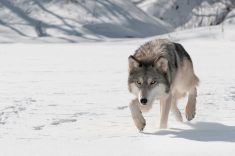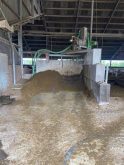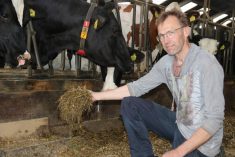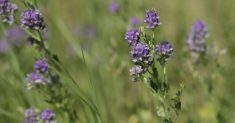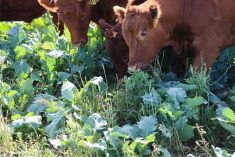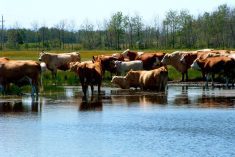In-field winter feeding can save time and money, while fostering healthy crop and forage growth, according to Jeff Schoenau of the University of Saskatchewan.
Schoenau and colleagues at the university’s College of Agriculture and Bioresources conducted a three-year study following the effects of in-field winter feeding on animal and pasture health, as well as on run-off water. He visited the University of Manitoba to talk to students about the results late last fall.
“In-field feeding is obviously superior,” he said, noting fields where cows were wintered showed a three- to fivefold increase in forage yield. The forage — in this case, Russian rye — also showed improved quality, particularly higher protein levels.
Read Also

Pig transport stress costs pork sector
Popular livestock trailer designs also increase pig stress during transportation, hitting at meat quality, animal welfare and farm profit, Agriculture and Agri-Food Canada researcher says
The research pitted in-field bale-grazing and swath-grazing systems against what Schoenau described as a more traditional feeding system, where feed is hauled to the yard, and manure is later hauled to the field.
He said the latter method sees the loss of nitrogen- and phosphorus-rich urine, in addition to the use of expensive fuel to haul both feed and manure.
Although there was no weight difference between cows that had been fed in field and those fed in the yard, animal health was positively impacted during the study as well, as animals had increased amounts of exercise during the colder months.
However, snow cover was an issue when the cows were feeding on swaths, which could become frozen and inaccessible during the height of winter.
Targeting the proper location is an important part of getting the best results, Schoenau said.
“When you move those bales onto the field, and put those cows out there, you’ve kind of got little fertilizer factories there,” he said. “So try to pick out an area on your farm that is nutrient or organic matter deficient, because that is where you’re going to see the biggest benefit in the crop growth or the forage growth.”
However, more nutrients on the ground surface during the spring melt and subsequent rains means more nutrients in run-off water, particularly phosphorus.
But Schoenau said this can be mitigated by appropriate in-field feeding site selection.
“The water that runs off will be nutrient enriched, and so you want to have that stay on the farm, you don’t want that entering into some kind of sensitive water body,” he stressed. “It all comes down to site selection, to ensure that water that is enriched with nutrients stays on your land, within your jurisdiction, as opposed to running off somewhere else.”
For farmers working in a knob and kettle landscape, where water naturally pools in on-farm locations, the researcher said containing the nutrient-enriched water should be straightforward, but farms operating near streams, rivers or creeks may have more difficulty keeping the water on site.
Studies have yet to be done to learn the effects of in-field grazing on greenhouse gas emissions.






